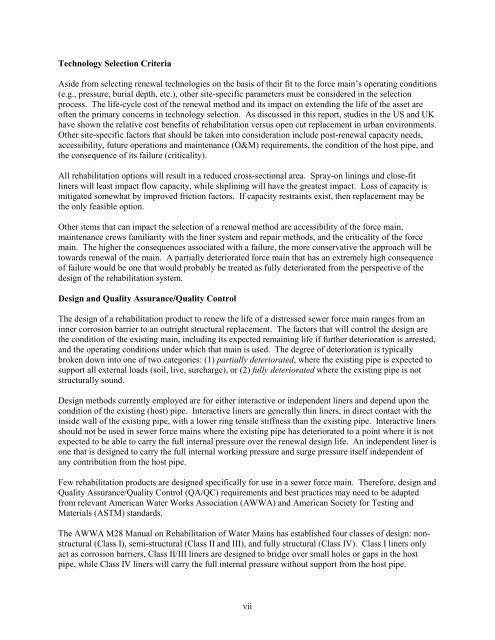State of Technology Report for Force Main Rehabilitation, Final ...
State of Technology Report for Force Main Rehabilitation, Final ...
State of Technology Report for Force Main Rehabilitation, Final ...
Create successful ePaper yourself
Turn your PDF publications into a flip-book with our unique Google optimized e-Paper software.
<strong>Technology</strong> Selection Criteria<br />
Aside from selecting renewal technologies on the basis <strong>of</strong> their fit to the <strong>for</strong>ce main’s operating conditions<br />
(e.g., pressure, burial depth, etc.), other site-specific parameters must be considered in the selection<br />
process. The life-cycle cost <strong>of</strong> the renewal method and its impact on extending the life <strong>of</strong> the asset are<br />
<strong>of</strong>ten the primary concerns in technology selection. As discussed in this report, studies in the US and UK<br />
have shown the relative cost benefits <strong>of</strong> rehabilitation versus open cut replacement in urban environments.<br />
Other site-specific factors that should be taken into consideration include post-renewal capacity needs,<br />
accessibility, future operations and maintenance (O&M) requirements, the condition <strong>of</strong> the host pipe, and<br />
the consequence <strong>of</strong> its failure (criticality).<br />
All rehabilitation options will result in a reduced cross-sectional area. Spray-on linings and close-fit<br />
liners will least impact flow capacity, while sliplining will have the greatest impact. Loss <strong>of</strong> capacity is<br />
mitigated somewhat by improved friction factors. If capacity restraints exist, then replacement may be<br />
the only feasible option.<br />
Other items that can impact the selection <strong>of</strong> a renewal method are accessibility <strong>of</strong> the <strong>for</strong>ce main,<br />
maintenance crews familiarity with the liner system and repair methods, and the criticality <strong>of</strong> the <strong>for</strong>ce<br />
main. The higher the consequences associated with a failure, the more conservative the approach will be<br />
towards renewal <strong>of</strong> the main. A partially deteriorated <strong>for</strong>ce main that has an extremely high consequence<br />
<strong>of</strong> failure would be one that would probably be treated as fully deteriorated from the perspective <strong>of</strong> the<br />
design <strong>of</strong> the rehabilitation system.<br />
Design and Quality Assurance/Quality Control<br />
The design <strong>of</strong> a rehabilitation product to renew the life <strong>of</strong> a distressed sewer <strong>for</strong>ce main ranges from an<br />
inner corrosion barrier to an outright structural replacement. The factors that will control the design are<br />
the condition <strong>of</strong> the existing main, including its expected remaining life if further deterioration is arrested,<br />
and the operating conditions under which that main is used. The degree <strong>of</strong> deterioration is typically<br />
broken down into one <strong>of</strong> two categories: (1) partially deteriorated, where the existing pipe is expected to<br />
support all external loads (soil, live, surcharge), or (2) fully deteriorated where the existing pipe is not<br />
structurally sound.<br />
Design methods currently employed are <strong>for</strong> either interactive or independent liners and depend upon the<br />
condition <strong>of</strong> the existing (host) pipe. Interactive liners are generally thin liners, in direct contact with the<br />
inside wall <strong>of</strong> the existing pipe, with a lower ring tensile stiffness than the existing pipe. Interactive liners<br />
should not be used in sewer <strong>for</strong>ce mains where the existing pipe has deteriorated to a point where it is not<br />
expected to be able to carry the full internal pressure over the renewal design life. An independent liner is<br />
one that is designed to carry the full internal working pressure and surge pressure itself independent <strong>of</strong><br />
any contribution from the host pipe.<br />
Few rehabilitation products are designed specifically <strong>for</strong> use in a sewer <strong>for</strong>ce main. There<strong>for</strong>e, design and<br />
Quality Assurance/Quality Control (QA/QC) requirements and best practices may need to be adapted<br />
from relevant American Water Works Association (AWWA) and American Society <strong>for</strong> Testing and<br />
Materials (ASTM) standards.<br />
The AWWA M28 Manual on <strong>Rehabilitation</strong> <strong>of</strong> Water <strong>Main</strong>s has established four classes <strong>of</strong> design: nonstructural<br />
(Class I), semi-structural (Class II and III), and fully structural (Class IV). Class I liners only<br />
act as corrosion barriers, Class II/III liners are designed to bridge over small holes or gaps in the host<br />
pipe, while Class IV liners will carry the full internal pressure without support from the host pipe.<br />
vii















